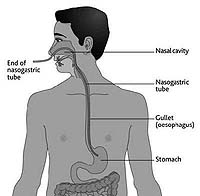|
|
|
Nutrition and Diagnosis-Related
Care
|
|
 What
can be done to improve the situation? What
can be done to improve the situation?
- Try to get him to stop drinking and
save what remains of his liver and pancreas.
- Optimize his residual liver and pancreas
function.
- Oral pancreatic enzyme replacement.
- Selectively increase protein and amino acid
intake so as to increase serum albumin levels and slow his
muscle proteolysis. Remember the aromatics.
- Meat is high in aromatics and
vegetable low.
- Figure protein at 1-1.5 gm/kg body
weight.
- Vitamin supplementation and use of
water-soluble vitamin formulations. Remember he can't absorb fats.
- Remember
his labs? What did you make
of that prolonged
PT?
- Vitamins here include not just the
fat soluble ones (especially K) but B-complex, C and minerals such
as zinc and magnesium.
- One must be cautious about too much
vitamin A and D.
- Calculate energy needs at 1.5 to
1.75 times the predicted or expected.

- If Mr. Bullroar's problem was just
his cirrhosis, we'd be shooting for a fat intake of about 40-50% of
his non-protein calories.
- However, his chronic pancreatitis
and diminished lipase output changes the dynamic. He will have
malabsorption and develop
steatorrhea.
- One will need to limit
long-chain triacylglycerol (LCT) fats.
- Avoid or limit caffeine because of
bowel motility and pancreas irritation.
- If he ends up with nasogastric
suction, which is pretty likely, we must be careful of his
electrolyte and acid-base balance.
So,
how did our man do? |
|